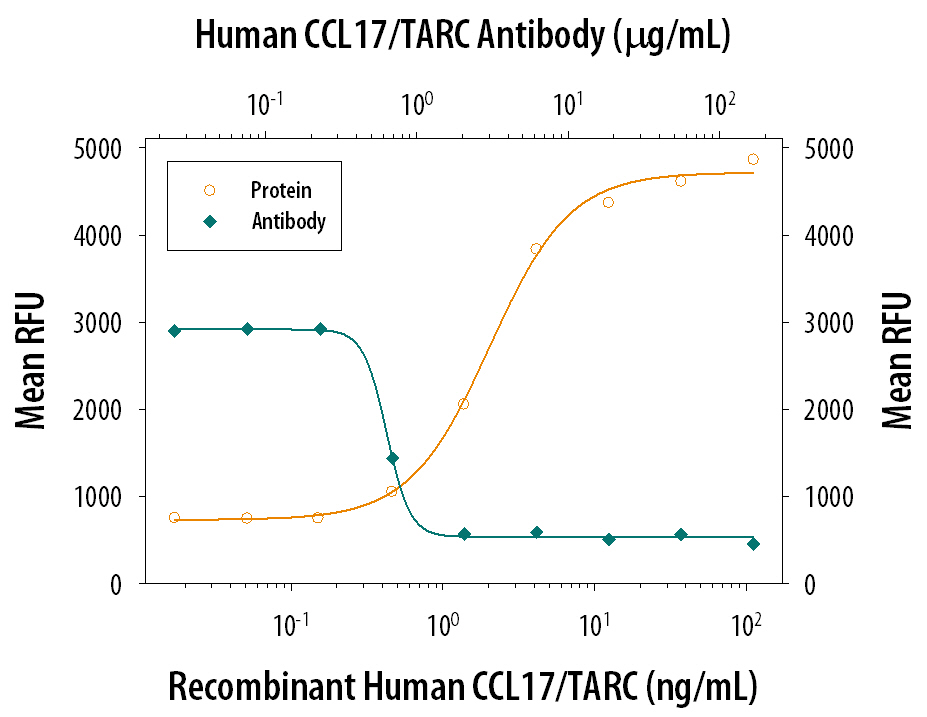Human CCL17/TARC Antibody Summary
Ala24-Ser94
Accession # Q92583.1
Applications
Human CCL17/TARC Sandwich Immunoassay
Please Note: Optimal dilutions should be determined by each laboratory for each application. General Protocols are available in the Technical Information section on our website.
Scientific Data
 View Larger
View Larger
Chemotaxis Induced by CCL17/TARC and Neutralization by Human CCL17/TARC Antibody. Recombinant Human CCL17/TARC (Catalog # 364-DN) chemoattracts the BaF3 mouse pro‑B cell line transfected with human CCR4 in a dose-dependent manner (orange line). The amount of cells that migrated through to the lower chemotaxis chamber was measured by Resazurin (Catalog # AR002). Chemotaxis elicited by Recombinant Human CCL17/TARC (10 ng/mL) is neutralized (green line) by increasing concentrations of Human CCL17/TARC Monoclonal Antibody (Catalog # MAB364). The ND50 is typically 0.4-2.0 µg/mL.
Reconstitution Calculator
Preparation and Storage
- 12 months from date of receipt, -20 to -70 °C as supplied.
- 1 month, 2 to 8 °C under sterile conditions after reconstitution.
- 6 months, -20 to -70 °C under sterile conditions after reconstitution.
Background: CCL17/TARC
CCL17 is a novel CC chemokine identified using a signal sequence trap method. CCL17 cDNA encodes a highly basic 94 amino acid (aa)residue precursor protein with a 23 aa residue signal peptide that is cleaved to generate the 71 aa residue mature secreted protein. Among CC chemokine family members, CCL17 has approximately 24-29% amino acid sequence identity with RANTES, MIP-1 alpha, MIP-1 beta, MCP-1, MCP-2, MCP-3, and I-309. The gene for human CCL17 has been mapped to chromosome 16q13 rather than chromosome 17 where the genes for many human CC chemokines are clustered. CCL17 is constitutively expressed in thymus, and at a lower level in lung, colon, and small intestine. CCL17 is also transiently expressed in stimulated peripheral blood mononuclear cells. Recombinant CCL17 has been shown to be chemotactic for T cell lines but not monocytes or neutrophils. CCL17 was identified to be a specific functional ligand for CCR4, a receptor that is selectively expressed on T cells.
- Imai, T. et al. (1997) J. Biol. Chem. 272:15036.
- Imai, T. et al. (1996) J. Biol. Chem. 271:21514.
- Nomiyama, H. et al. (1997) Genomics 40:211.
Product Datasheets
Citations for Human CCL17/TARC Antibody
R&D Systems personnel manually curate a database that contains references using R&D Systems products. The data collected includes not only links to publications in PubMed, but also provides information about sample types, species, and experimental conditions.
8
Citations: Showing 1 - 8
Filter your results:
Filter by:
-
Lung transplantation affects expression of the chemokine receptor type 4 on specific T cell subsets.
Authors: Paantjens AW, van de Graaf EA, Kwakkel-van Erp JM, Hoefnagel T, van Kessel DA, van den Bosch JM, Otten HG
Clin. Exp. Immunol., 2011-10-01;166(1):103-9.
Species: Human
Sample Types: Serum
Applications: ELISA Development -
CCL17 and CCL22 chemokines within tumor microenvironment are related to accumulation of Foxp3+ regulatory T cells in gastric cancer.
Authors: Mizukami Y, Kono K, Kawaguchi Y, Akaike H, Kamimura K, Sugai H, Fujii H
Int. J. Cancer, 2008-05-15;122(10):2286-93.
Species: Human
Sample Types: Whole Cells
Applications: Bioassay -
Specific recruitment of regulatory T cells into the CSF in lymphomatous and carcinomatous meningitis.
Authors: Haas J, Schopp L, Storch-Hagenlocher B, Fritzsching B, Jacobi C, Milkova L, Fritz B, Schwarz A, Suri-Payer E, Hensel M, Wildemann B
Blood, 2007-10-29;111(2):761-6.
Species: Human
Sample Types: Whole Cells
Applications: Neutralization -
Generation of Th1 and Th2 chemokines by human eosinophils: evidence for a critical role of TNF-alpha.
Authors: Liu LY, Bates ME, Jarjour NN, Busse WW, Bertics PJ, Kelly EA
J. Immunol., 2007-10-01;179(7):4840-8.
Species: Human
Sample Types: Cell Culture Supernates
Applications: ELISA Development -
TARC augments TNF-alpha-induced CTACK production in keratinocytes.
Authors: Vestergaard C, Johansen C, Christensen U, Just H, Hohwy T, Deleuran M
Exp. Dermatol., 2004-09-01;13(9):551-7.
Species: Human
Sample Types: Cell Culture Supernates, Whole Cells
Applications: Neutralization -
Specific recruitment of regulatory T cells in ovarian carcinoma fosters immune privilege and predicts reduced survival.
Authors: Curiel, Tyler J, Coukos, George, Zou, Linhua, Alvarez, Xavier, Cheng, Pui, Mottram, Peter, Evdemon-Hogan, Melina, Conejo-Garcia, Jose R, Zhang, Lin, Burow, Matthew, Zhu, Yun, Wei, Shuang, Kryczek, Ilona, Daniel, Ben, Gordon, Alan, Myers, Leann, Lackner, Andrew, Disis, Mary L, Knutson, Keith L, Chen, Lieping, Zou, Weiping
Nat Med, 2004-08-22;10(9):942-9.
Species: Human
Sample Types: Whole Cells
Applications: Neutralization -
Enhanced generation of helper T type 1 and 2 chemokines in allergen-induced asthma.
Authors: Liu L, Jarjour NN, Busse WW, Kelly EA
Am. J. Respir. Crit. Care Med., 2004-03-04;169(10):1118-24.
Species: Human
Sample Types: BALF
Applications: ELISA Development -
Chemokine receptor CCR4 on CD4+ T cells in juvenile rheumatoid arthritis synovial fluid defines a subset of cells with increased IL-4:IFN-gamma mRNA ratios.
Authors: Thompson SD, Luyrink LK, Graham TB, Tsoras M, Ryan M, Passo MH, Glass DN
J. Immunol., 2001-06-01;166(11):6899-906.
Species: Human
Sample Types: Synovial Fluid
Applications: ELISA Development
FAQs
No product specific FAQs exist for this product, however you may
View all Antibody FAQsReviews for Human CCL17/TARC Antibody
Average Rating: 5 (Based on 1 Review)
Have you used Human CCL17/TARC Antibody?
Submit a review and receive an Amazon gift card.
$25/€18/£15/$25CAN/¥75 Yuan/¥2500 Yen for a review with an image
$10/€7/£6/$10 CAD/¥70 Yuan/¥1110 Yen for a review without an image
Filter by:




